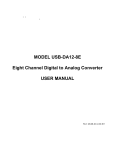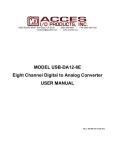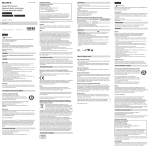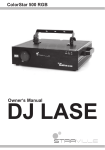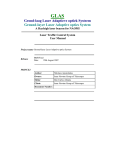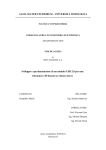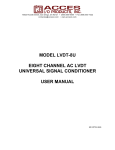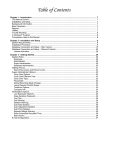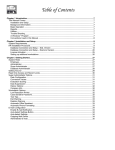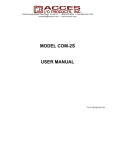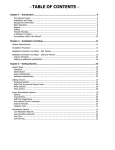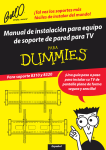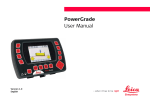Download MODEL USB-DA12-8A Eight Channel Digital to
Transcript
10623 Roselle Street, San Diego, CA 92121 C (858) 550-9559 C Fax (858) 550-7322 [email protected] C www.accesio.com MODEL USB-DA12-8A Eight Channel Digital to Analog Converter with ARB (Arbitrary Waveform Generator) USER MANUAL FILE: MUSB-DA12-8A.B1d Notice The information in this document is provided for reference only. ACCES does not assume any liability arising out of the application or use of the information or products described herein. This document may contain or reference information and products protected by copyrights or patents and does not convey any license under the patent rights of ACCES, nor the rights of others. IBM PC, PC/XT, and PC/AT are registered trademarks of the International Business Machines Corporation. Printed in U SA . Copyright 2005, 2007 by AC CES I/O Products In c, 1 0623 Ro selle Street, S an Die go, CA 92121. All rights reserved. WARNING!! ALWAYS CONNECT AND DISCONNECT YOUR FIELD CABLING WITH THE COMPUTER POWER OFF. ALWAYS TURN COMPUTER POWER OFF BEFORE INSTALLING A CARD. CONNECTING AND DISCONNECTING CABLES, OR INSTALLING CARDS INTO A SYSTEM WITH THE COMPUTER OR FIELD POWER ON MAY CAUSE DAMAGE TO THE I/O CARD AND WILL VOID ALL WARRANTIES, IMPLIED OR EXPRESSED. 2 Manual USB-DA12-8A Warranty Prior to shipm ent, AC CE S eq uipm ent is thorou ghly insp ecte d an d tested to applicable specification s. H ow ever, sh ould equipment failure occu r, ACCE S assu res its custom ers that prom pt s ervice and support will be available. A ll equipment originally manufactured by ACCES which is found to be defective will be repa ired or replaced su bjec t to the following considerations. Terms and Conditions If a unit is suspected of failure, contact ACCES' Customer Service department. Be prepared to give the unit model num ber, serial num ber, a nd a des cription of the failure s ym ptom (s). W e m ay suggest som e simp le tests to confirm the failure. W e will assign a Return Material Authorization (RMA) num ber which must appear on the outer label of the return package. All units/components should be properly packed for handling and returned with freight prepaid to the ACCES designated Service Center, and will be returned to the customer's/user's site freight prepaid and invoiced. Coverage First Three Years: Returned unit/part will be repaired and/or replaced at ACCES option with no charge for labor or parts not excluded by warranty. W arranty com m enc es w ith equ ipm ent shipm ent. Following Years: T hroughout your eq uipm ent's lifetim e, A CCES sta nds ready to provide on-site or in-plant service at reasonable rates sim ilar to those of other m anufacturers in the industry. Equipment Not Manufactured by ACCES Equipment pro vided but not m anufactured by ACCES is warranted and will be repaired acco rding to the terms and conditions of the re spective equipm ent m anufacturer's w arranty. General Under this W arranty, lia bility of ACCES is lim ited to replacing, repairing or issuing credit (at ACCES discretion) for any products which are proved to be defective during the warranty period. In no case is ACCES liable for consequential or special damage arriving from use or misuse of our product. The customer is responsible fo r all charges caused by modifications or additions to ACCES equipment not approved in writing by ACCES or, if in ACCES opinion the equipment has been subjected to abnorm al use. "Ab norm al use" for pu rposes of this warranty is defined as any use to which the equipment is exposed other than that use specified or intended as evidenced by purchase or sales representation. Other than the above, no other warranty, expressed or im plied, s hall apply to any and all such equipment furnished or sold by ACCES. 3 Manual USB-DA12-8A Table of Contents Chapter 1: Introduction . . . . . . . . . . . . . . . . . . . . . . . . . . . . . . . . . . . . . . . . . . . . . . . . . . . . . 5 Features . . . . . . . . . . . . . . . . . . . . . . . . . . . . . . . . . . . . . . . . . . . . . . . . . . . . . . . . . . . . . . . . . . . . Applications . . . . . . . . . . . . . . . . . . . . . . . . . . . . . . . . . . . . . . . . . . . . . . . . . . . . . . . . . . . . . . . . . . Functional Description . . . . . . . . . . . . . . . . . . . . . . . . . . . . . . . . . . . . . . . . . . . . . . . . . . . . . . . . . . Model Options . . . . . . . . . . . . . . . . . . . . . . . . . . . . . . . . . . . . . . . . . . . . . . . . . . . . . . . . . . . . . . . . Special Order . . . . . . . . . . . . . . . . . . . . . . . . . . . . . . . . . . . . . . . . . . . . . . . . . . . . . . . . . . . . . . . . Included with your shipment . . . . . . . . . . . . . . . . . . . . . . . . . . . . . . . . . . . . . . . . . . . . . . . . . . . . . Optional Accessories . . . . . . . . . . . . . . . . . . . . . . . . . . . . . . . . . . . . . . . . . . . . . . . . . . . . . . . . . . . Specifications . . . . . . . . . . . . . . . . . . . . . . . . . . . . . . . . . . . . . . . . . . . . . . . . . . . . . . . . . . . . . . . . 5 5 5 6 6 6 6 7 Chapter 2: Installation . . . . . . . . . . . . . . . . . . . . . . . . . . . . . . . . . . . . . . . . . . . . . . . . . . . . . . 9 Software CD Installation . . . . . . . . . . . . . . . . . . . . . . . . . . . . . . . . . . . . . . . . . . . . . . . . . . . . . . . . 9 Hardware Installation . . . . . . . . . . . . . . . . . . . . . . . . . . . . . . . . . . . . . . . . . . . . . . . . . . . . . . . . . . . 9 USB I/O Quick-Start Guide . . . . . . . . . . . . . . . . . . . . . . . . . . . . . . . . . . . . . . . . . . . . . . . . . . . . . . 9 Chapter 3: Option Selection . . . . . . . . . . . . . . . . . . . . . . . . . . . . . . . . . . . . . . . . . . . . . . . . 10 DC Power Jack . . . . . . . . . . . . . . . . . . . . . . . . . . . . . . . . . . . . . . . . . . . . . . . . . . . . . . . . . . . . . . Output Voltage Range Jumpers . . . . . . . . . . . . . . . . . . . . . . . . . . . . . . . . . . . . . . . . . . . . . . . . . Differential Outputs (J3) . . . . . . . . . . . . . . . . . . . . . . . . . . . . . . . . . . . . . . . . . . . . . . . . . . . . . . . Control and Monitoring (J4) . . . . . . . . . . . . . . . . . . . . . . . . . . . . . . . . . . . . . . . . . . . . . . . . . . . . . Single Ended Outputs (J1) . . . . . . . . . . . . . . . . . . . . . . . . . . . . . . . . . . . . . . . . . . . . . . . . . . . . . USB Connector . . . . . . . . . . . . . . . . . . . . . . . . . . . . . . . . . . . . . . . . . . . . . . . . . . . . . . . . . . . . . . LED Light . . . . . . . . . . . . . . . . . . . . . . . . . . . . . . . . . . . . . . . . . . . . . . . . . . . . . . . . . . . . . . . . . . 11 11 11 11 11 11 11 Chapter 4: USB Address Information . . . . . . . . . . . . . . . . . . . . . . . . . . . . . . . . . . . . . . . . . 12 Chapter 5: Programming . . . . . . . . . . . . . . . . . . . . . . . . . . . . . . . . . . . . . . . . . . . . . . . . . . . 13 Software Reference Manual . . . . . . . . . . . . . . . . . . . . . . . . . . . . . . . . . . . . . . . . . . . . . . . . . . . . 13 Vendor Requests . . . . . . . . . . . . . . . . . . . . . . . . . . . . . . . . . . . . . . . . . . . . . . . . . . . . . . . . . . . . 13 USB-DA12-8A Vendor Request document text . . . . . . . . . . . . . . . . . . . . . . . . . . . . . . . . . . . . . . 13 Chapter 6: Connector Pin Assignments . . . . . . . . . . . . . . . . . . . . . . . . . . . . . . . . . . . . . . . 18 J4 Signal descriptions (Control / Status) . . . . . . . . . . . . . . . . . . . . . . . . . . . . . . . . . . . . . . . . . . . 19 ILDA DB-25 Pinout and Signal Description Standard Excerpts . . . . . . . . . . . . . . . . . . . . . . . . . . 21 References: . . . . . . . . . . . . . . . . . . . . . . . . . . . . . . . . . . . . . . . . . . . . . . . . . . . . . . . . . . . . . . . . 22 List of Figures Figure 1-1: Block Diagram . . . . . . . . . . . . . . . . . . . . . . . . . . . . . . . . . . . . . . . . . . . . . . . . . . . . . . . . . . . . . . . . . . . . 8 Figure 3-1: Option Selection Map . . . . . . . . . . . . . . . . . . . . . . . . . . . . . . . . . . . . . . . . . . . . . . . . . . . . . . . . . . . . . . 10 List of Tables Table Ta ble Ta ble Ta ble Ta ble Table 6-1: J4, Control/Status 10-Pin IDC . . . . . . . . . . . . . . . . . . . . . . . . . . . . . . . . . . . . . 6-2: J1, S.E. O utpu ts, 16-Pin ID C A ssignm ents . . . . . . . . . . . . . . . . . . . . . . . . . . . 6-3: S.E . Ou tputs, Control/Status, DB 25 M ale C onn ecto r Pin A ssignm ents . . . . . 6-4: J3, Differential Analog O utpu ts, 26-Pin ID C A ssignm ents . . . . . . . . . . . . . . . 6-5: Differential Analog Ou tputs, DB 25F Conne ctor P in Assignm ents . . . . . . . . . 6-6: ILDA Signal Nam ing Standard, DB25F Signal Descriptions . . . . . . . . . . . . . . 4 . . . . . . . . . . . . .. .. .. .. .. .. . . . . . . . . . . . . ...... ...... ...... ...... ...... ...... . . . . . . . . . . . . .. .. .. .. .. .. . . . . . . . . . . . . Manual USB-DA12-8A . . . . . . 18 18 18 20 20 21 Chapter 1: Introduction Features • • • • • • • • • • • • • • High-speed USB 2.0 device, USB 1.1 compatible Small, portable 8-channel, 12-bit, digital to analog converter outputs Double-buffered allowing simultaneous update of all DAC’s Up to 125K conversions per DAC per second Streaming USB waveform data at over 400,000 DAC outputs per second total ILDA (International Laser Display Association) compatible outputs 256K byte buffer on-board, or infinitely long streaming waveforms Buffered waveforms at up to 1 million DAC conversions per second total Analog output ranges of 0-2.5V, 0-5V, 0-10V, ±2.5V, ±5V, ±10V Single-ended and differential outputs on separate connectors Custom high-speed function driver PC/104 module size and mounting compatibility Small (4"x4"x1.75") rugged industrial enclosure DB25M and DB25F enclosure mounted I/O connectors Applications • • • • • Portable / Laptop Education / Laboratory Industrial Automation Embedded OEM ILDA Laser Driver Functional Description The USB-DA12-8A is an ideal solution for adding portable, easy-to-install analog outputs to any computer with a USB port. The unit is a high speed USB 2.0 device, offering the highest speed available with the USB bus. It is fully compatible with both USB 1.1 and USB 2.0 ports. The board is plug-and-play allowing quick connection whenever you need additional I/O on a USB port. This product features 8 digital-to-analog converters (DACs) with both differential and single-ended outputs on separate connectors. The board features unipolar and bipolar ranges for each DAC giving the user a variety of options. The DACs can be updated individually or simultaneously. To ensure that there will not be excessive outputs to external circuits when the board is plugged in, automatic circuits limit analog outputs to zero volts. Five Volt (5V) Power is supplied to the board by an external regulated power supply which powers DC/DC converters to provide ±12V to the operational amplifiers on the board. The I/O wiring depends on the model option(s) ordered. For the OEM version, connections are via industry standard, IDC type 26-pin, 16-pin and 10-pin connectors. For full, standard versions, connections are made to the IDC connectors on-board via internal cables from enclosure mounted DB25 connectors, with one screw terminal accessory being included (model ADAP25). 5 Manual USB-DA12-8A The USB-DA12-8A is designed to be used in rugged industrial environments but is small enough to fit nicely onto any desk or testing station. The board is PC/104 sized (3.550 by 3.775 inches) and ships inside a steel powder-coated enclosure with an anti-skid bottom. Model Options USB-DA12-8A -OEM -PR Module installed in an enclosure with two (2) DB25 I/O connectors and one (1) screw terminal accessory (ADAP25) Board only version with I/O headers Power Adaptor, AC/DC 5V regulated. Special Order Resistors in series with differential connector for impedance matching, contact factory with your requirement. Included with your shipment The following components are included with your shipment, depending on options ordered. Please take the time now to ensure that no items are damaged or missing. ! ! ! ! ! ! USB-DA12-8A ADAP25, Screw Terminal Adaptor, qty 1 6' USB cable 115VAC to 5VDC Regulated Power Supply wall adaptor Software Master CD USB I/O Quick-Start Guide Optional Accessories ! ! ADAP25(M), Screw Terminal Adaptor (an additional unit could be needed if you intended on using the Single-Ended and the Differential Analog Outputs). -DIN DIN Rail Mounting Provision 6 Manual USB-DA12-8A Specifications Analog Outputs Number of Outputs: Type of Outputs: Resolution: Unipolar Ranges: Bipolar Ranges: Conversion Rate: Relative Accuracy: Differential Non-linearity: Settling Time: Output Current: 8 channels Single-ended and differential 12-bit resolution 0-2.5V, 0-5V, 0-10V ±2.5V, ±5V, ±10V 125kHz, all channels simultaneous ±2 LSB typical ±0.2 LSB typical 8us typical, 10us max 6mA per channel Bus Type USB2.0 High-speed, USB1.1 Full-speed compatible Environmental Operating Temperature: Storage Temperature: Humidity: Board Dimension: Box Dimension: 0O to 70OC -40O to +85OC 5% to 95% non-condensing 3.550 x 3.775 inches 4 x 4 x 1.75 inches tall Power +5VDC @ ~520mA typical, no-load on DAC outputs** ** Regulated AC/DC adapter should be ordered (“-PR” option) together with the board as the minimum current draw exceeds that which the USB port can provide by default. 7 Manual USB-DA12-8A Figure 1-1: Block Diagram 8 Manual USB-DA12-8A Chapter 2: Installation Software CD Installation This paragraph is intended to detail the software installation steps. The software provided with this board is contained on one CD and must be installed onto your hard disk prior to use. To do this, perform the following steps as appropriate for your software format and operating system. Substitute the appropriate drive letter for your CD-ROM or disk drive where you see d: in the examples below. WIN95/98/Me/NT/2000/XP/2003 a. b. c. Place the CD into your CD-ROM drive. The CD should automatically run the install program. If the install program does not click START | RUN and type d:install, click OK or press K. Follow the on-screen prompts to install the software for this board. Hardware Installation The USB-DA12-8A board can be installed in any USB 2.0 or USB 1.1 port. Please refer to the USB I/O Quick Start Guide which can be found on the CD, for specific, quick steps to complete the hardware and software installation. USB I/O Quick-Start Guide Provides quick and straight-forward steps to complete the software and hardware installation of this product in your system. 9 Manual USB-DA12-8A Chapter 3: Option Selection Refer to the setup programs on the CD provided with the board. Also, refer to the Block Diagram and the Option Selection Map when reading this section of the manual. Figure 3-1: Option Selection Map 10 Manual USB-DA12-8A DC Power Jack This is the DC input connector used to provide a regulated +5V power supply to the card without using the USB bus. Be sure to order option -PR so this wall adaptor will be included with your shipment. Output Voltage Range Jumpers Use the jumpers to select the range that you wish to use. Each channel is configured individually for the following output possibilities. 0 to 2.5V 0 to 5V 0 to 10V -2.5 to 2.5V -5 to 5V -10 to 10 V Differential Outputs (J3) These are the Differential DAC outputs. Control and Monitoring (J4) This 10-pin connector provides an alternate means to start and stop the ARB and monitor it’s status. Single Ended Outputs (J1) These are the Single Ended DAC outputs. USB Connector The USB connector on this board is a USB type B. LED Light LED indicates Power and Activity 11 Manual USB-DA12-8A Chapter 4: USB Address Information Use the provided driver to access the USB board. This driver will allow you to determine how many supported USB devices are currently installed, and each device’s type. This information is returned as a Vendor ID (VID), Product ID (PID) and Device Index. The board’s VID is “0x1605", and its PID is “0x8001". The Device Index is determined by how many of the device you have in your system, and provides a unique identifier allowing you to access a specific board at will. 12 Manual USB-DA12-8A Chapter 5: Programming The installation program on the CD will install four PDF manuals to your hard drive. These are the USB I/O Quick-Start Guide, User Manual, Software Reference Manual, and super-softwaretech manual; Vendor Requests. Software Reference Manual Details our various drivers and sample programs in a number of programming languages as well as providing insight into the most optimum combination of language, environment/OS and hardware selection available. Vendor Requests This file provides information on a RAW USB INTERFACE for very low-level programming, generally in Operating Systems other than Windows. USB-DA12-8A Vendor Request document text This device was originally designed for ILDA waveform playback. ILDA is used heavily in the laser “movie” environment, for laser light-shows. As a result, much of the terminology used in this document refers to a “movie” file. In every case where “movie” occurs you can use “waveform” just as precisely. Where you see movie-centric terms like “play” you can substitute “start” or “run”. Vendor Specific (endpoint 0, control) Requests B0, B1, B2, B3, B4, and B5 (hex) are defined by the firmware. (Just to define some terms: setupdat[5] is MSB of "index", setupdat[4] is LSB of index. setupdat[3] is MSB of "value", setupdat[2] is LSB of value. ) Endpoint 0 Vendor Requests: B0: One byte passed down in Value (setupdat[2]). Bit 7 is "reset", d6 is "pause", d0 is "play" If D7 is set, the cpld is reset, run is stopped, and the LEDs are reset to off. If D6 is set nothing particular happens. This bit is reserved for future use. If D0 is set the DAC reference voltage is woken up (voltage starts coming out the DACs), and the SRAM starts playing. B1: setupdat[4] is LSB and setupdat[5] is MSB, of the location in the onboard SRAM that bulk transfers should load into. Each bank is 0x1FFF in size. Bank 0 through Bank 7 map contiguously to create a 0xFFFF byte buffer. Writing to the 0xFFFFth byte causes the SRAM to toggle to the other SRAM. Setupdat[3] is the "bank", and only 0-7 are valid. B1 must be called before endpoint 2 can be used to load the data into the SRAM. 13 Manual USB-DA12-8A B2: Index holds the counter load value for the "RATE" counter. This divisor controls the rate at which the SRAM will feed out into the DACs. A load value of 190h works out to 30KHz update rate. B3: reserved for future use B4: this causes the endpoint to lockup until the SRAM switches from the current to the next. B5: reserved for future use Endpoint 2: Bulk Data In Does nothing (and probably hangs) if you haven't called Vendor Request B1 Takes the blocks of data and writes them into the SRAM. Don't load more data than the sum of both SRAMs. How to use this information: To use the card, issue a Vendor request B0-reset, issue a Vendor request B2 to select the rate you want the counters to run, then load the onboard memory. This board contains two SRAMs, each 64KBytes long, for a total of 64KWords of onboard storage. The board has two internal pointers, a “play” pointer, and a “write’ pointer. Calling VR B1 sets the write pointer. So does issuing a reset via VR B0 (to zero). The play pointer is set to zero, in the *other* SRAM. Setting the write pointer to the last spot in SRAM and issuing a write swaps the SRAMs the two pointers refer to. It is not possible for the write and play pointer to be pointing to the same SRAM. This memory acts like a circular buffer, where the head and tail can’t be in the same half of the buffer. If you reset then load 64KWords-1, the Play pointer will be at Zero in SRAM0, the write pointer will be at 0xfffe in SRAM1, effectively one word away, but still in the other half of memory. A program to control the DACs must generate a "movie" file. This file consists of an array of DAC data words. The format of one word is both binary and bit-mapped as follows: D15 D14 D13 D12 D11 through D0 EOM EOF EOD LOOP DAC Value 0-FFF, hex 0-4095 dec EOM is “end of movie”. Set this bit to cause the DAC waveforms to halt. If you do not set EOM on the last data in your array the DACs will continue to read out uninitialized SRAM and simply repeat forever. EOF is “end-of-frame”. Set this bit to cause a particular digital output bit to indicate the bit was set during playback. 14 Manual USB-DA12-8A EOD is “end-of-DACs”. Set this bit to indicate “start counting DACs over at zero” (see below) LOOP is “loop”, and can be set to cause the circuit to set the internal pointer into the current location in SRAM back to “zero” in the first SRAM. If you load a small array of DAC data and set loop on the last data point, it will simply play forever (unless EOM was set somewhere before loop) The format of the array: The array contains data for all DACs interleaved. The simplest possible array would look like this: 0 0 0 0 DAC 0 value 0 0 0 0 DAC 1 value 0 0 0 0 DAC 2 value 0 0 0 0 DAC 3 value 0 0 0 0 DAC 4 value 0 0 0 0 DAC 5 value 0 0 0 0 DAC 6 value 1 0 0 0 DAC 7 value Running this movie would cause the card to initialize the 8 dac values then stop, effectively creating a DC output on all DACs. (Note, you could have cleared EOM and set LOOP for the same effect, but you would then waste cycles repeating the same DC data) If you wanted to produce a square wave on all DACs you could double the waveform buffer and loop: 0 0 0 0 0 0 0 0 0 0 0 0 0 0 0 0 0 0 0 0 0 0 0 0 0 0 0 0 0 0 0 0 0 0 0 0 0 0 0 0 0 0 0 0 0 0 0 0 0 0 0 0 0 0 0 0 0 0 0 0 0 0 0 1 DAC 0 value DAC 1 value DAC 2 value DAC 3 value DAC 4 value DAC 5 value DAC 6 value DAC 7 value DAC 0 value DAC 1 value DAC 2 value DAC 3 value DAC 4 value DAC 5 value DAC 6 value DAC 7 value 15 Manual USB-DA12-8A If you don’t want to use all 8 DACs you can set EOD on the last DAC you do want to use. If you were using 3 DACs your waveform array might look like this: 0 0 0 0 0 0 0 0 0 0 0 0 0 0 1 0 0 1 0 0 0 0 0 1 DAC 0 value DAC 1 value DAC 2 value DAC 0 value DAC 1 value DAC 2 value This EOD functionality allows complex relationships between rates of output. If DAC 1 is going to output at one-third the rate of DAC 0: 0 0 0 0 0 0 0 0 0 0 0 0 0 0 0 0 1 1 0 1 1 1 0 1 0 0 0 0 0 0 0 1 DAC 0 value DAC 0 value DAC 0 value DAC 1 value DAC 0 value DAC 0 value DAC 0 value DAC 1 value Careful understanding of this EOD functionality is critical to correctly creating a waveform/movie buffer. Here’s a more complex example. 0 0 0 0 0 0 0 0 0 0 0 0 0 0 0 0 0 0 0 0 0 0 0 0 0 0 0 0 1 0 0 1 1 0 0 0 0 0 1 0 1 0 0 0 0 0 0 0 0 0 0 0 0 0 0 1 DAC 0 value DAC 0 value DAC 1 value DAC 2 value DAC 0 value DAC 0 value DAC 1 value DAC 2 value DAC 3 value DAC 4 value DAC 5 value DAC 0 value DAC 1 value DAC 0 value If you never set EOD the DACs *should* increment from 0 to 7, wrap to 0, and repeat, but this is untested. It’s a good idea to simply always set EOD on the last DAC’s data value. 16 Manual USB-DA12-8A Loading the array: The array is loaded by issuing a vendor request (VR) B1 to specify the starting location of the next buffer in the SRAM. Typically VR B1 with “0000" and “bank 0" in the parameters (refer to the discussion of VR B1, above) is the first instruction issued. Then, EP2 bulk transfers are initiated for the first 64KWords of your waveform file. If your waveform is smaller than 64KWords, simply load the entire waveform (and you’ll want EOM or LOOP set to avoid playing uninitialized SRAM.) If your waveform is smaller than 32KWords you must take an extra step: Issue a VR B1 with 1FFE/Bank7, then EP2 a single WORD. This sets the internal “write” pointer into the second SRAM. This is necessary because the “Play” pointer is always in the SRAM you’re NOT writing into. If your waveform is smaller than 64KWords there is no streaming needed, simply issue a VR B0 “run” command to cause the DACs to start outputting data. If your waveform is larger than the onboard memory, load more than one 32KWords but less than 64KWords with your file, then issue a “run”, then continue loading your file. The EP2 Bulk transfers to load the SRAM will *hang* until there is room in the SRAM for more data. Your code must handle this apparent lockup. Multithreaded is recommended. 17 Manual USB-DA12-8A Chapter 6: Connector Pin Assignments Three header connectors provide a means to interface with the on-board signals. There is a 26 pin header for differential analog outputs, a 16 pin header for single ended analog outputs and a 10 pin header for control and status of the board’s functions. When ordered as a standard unit (no options selected) the board is installed in a steel powder coated enclosure with mounted DB25 connectors. One ADAP25 screw terminal accessory is included and can be plugged onto the single ended outputs/ control and status DB25M (male) connector. The second DB25F (female) is the opposite of the first, to avoid plugging onto the wrong connector which has a different pinout than the first. Function Pin Pin EOF 1 2 Function EOD Status 3 4 Blank Ext. Trigger 5 6 Pause Interlock 7 8 Loop Ground 9 10 N/C Table 6-1: J4, Control/Status 10-Pin IDC Table 6-2: J1, S.E. Outputs, 16-Pin IDC Assignments DB25M 1 2 3 4 5 6 7 8 9 10 11 12 13 Function DAC 0 DAC 1 DAC 2 DAC 3 DAC 4 DAC 5 DAC 6 DAC 7 EOF Status Ext. Trigger Interlock Ground IDC J1-1 J1-3 J1-5 J1-7 J1-9 J1-11 J1-13 J1-15 J4-1 J4-3 J4-5 J4-7 J4-9 DB25M 14 15 16 17 18 19 20 21 22 23 24 25 Function Ground Ground Ground Ground Ground Ground Ground Ground EOD Blank Pause Loop IDC J1-2 J1-4 J1-6 J1-8 J1-10 J1-12 J1-14 J1-16 J4-2 J4-4 J4-6 J4-8 Table 6-3: S.E. Outputs, Control/Status, DB25 Male Connector Pin Assignments 18 Manual USB-DA12-8A J4 Signal descriptions (Control / Status) Outputs: EOF EOD STATUS BLANK “End of Frame”, output every time EOF is issued. “End of DAC”, output every time DAC starts at 0. User controlled via Firmware. Output blanking signal from top bits of EOM, EOF, EOD.... Inputs: EXT. TRIGGER PAUSE INTERLOCK LOOP To Ctr 0, starts D/A conversions. To gate 0 of counter. “Shutdown” Digital Input (Firmware controlled). Loops contents of SRAM, resets pointer to beginning of SRAM 0. All signals at J4 pass through a line buffer, and all input signals are pulled to +5V through 47Kohms each. Activate input signals by applying 0V or a ground to the associated pin. 19 Manual USB-DA12-8A Table 6-4: J3, Differential Analog Outputs, 26-Pin IDC Assignments DB25F Function IDC IDC Function DB25F 1 DAC 0+ 1 2 DAC 0- 14 2 DAC 1+ 3 4 DAC 1- 15 3 DAC 2+ 5 6 DAC 2- 16 4 Interlock 7 8 Interlock 17 5 DAC 3+ 9 10 DAC 3- 18 6 DAC 4+ 11 12 DAC 4- 19 7 DAC 5+ 13 14 DAC 5- 20 8 DAC 6+ 15 16 DAC 6- 21 9 DAC 7+ 17 18 DAC 7- 22 10 N/C 19 20 N/C 23 11 N/C 21 22 N/C 24 12 N/C 23 24 N/C 25 13 Ground 25 26 N/C N/C Table 6-5: Differential Analog Outputs, DB25F Connector Pin Assignments 20 Manual USB-DA12-8A ILDA DB-25 Pinout and Signal Description Standard Excerpts Pins Signal Names Signal Description 1, 14 X+, X- Controls the horizontal beam position. This is a bipolar analog signal whose voltage range is 10V peak-to-peak differential. A differential voltage level of -10V shall deflect the laser beam to the left side of the projection area. A differential voltage level of +10V shall deflect the signal to the right side. A differential voltage of +10V occurs if the normal signal line has a voltage level of +10V with respect to the voltage level of the inverted signal line. When compared to the ground level of the differential driver, the voltage level of the normal signal line shall be +5V and the level of the inverted signal shall be -5V. 2, 15 Y+, Y- Controls the vertical beam position. This is a bipolar analog signal whose voltage range is 10V peak-to-peak differential. A differential voltage level of -10V shall deflect the laser beam to the bottom of the screen. A differential voltage level of +10V shall deflect the signal to the top of the screen. A differential voltage level of 0V shall place the beam in the center of the screen vertically. A differential voltage of +10V occurs if the normal signal line has a voltage level of +10V with respect to the voltage level of the inverted signal line. When compared to the ground level of the differential driver, the voltage level of the normal signal line shall be +5V and the voltage level of the inverted signal shall be -5V. 3, 16 Intensity + Intensity 4, 17 Interlock A Interlock B These are intended to keep the projector from outputting light if inadvertently connected to nonlaser signal sources such as SCSI, Parallel or serial connectors. These signals are also a fail-safe should other control measures fail. These signals are tied together at the signal source. If this loop is broken, it is required that projectors close a shutter or turn off the laser or take other actions that prevent light from being emitted from the projector. It is important to note that this portion of the ISPDB25 is a projector interlock which may be separate from the remote interlock connector on a laser used with the projector. 5, 18 R+, R- Controls the red intensity. This is a unipolar analog signal whose voltage range is 5V peak-to-peak differential. A differential voltage level of 0V shall produce no red output. A differential voltage level of +5V shall produce maximum red output. A differential voltage of +5V occurs if the normal signal line has a voltage level of +5V with respect to the voltage level of the inverted signal line. When compared to the ground level of the differential driver, the voltage level of the normal signal line shall be +2.5V and the voltage level of the inverted signal shall be -2.5V. 6, 19 G+, G- Controls the green intensity. This is a unipolar analog signal whose voltage range is 5V peak-to-peak differential. A differential voltage level of 0V shall produce no green output. A differential voltage level of +5V shall produce maximum green output. A differential voltage of +5V occurs if the normal signal line has a voltage level of +5V with respect to the voltage level of the inverted signal line. When compared to the ground level of the differential driver, the voltage level of the normal signal line shall be +2.5V and the voltage level of the inverted signal shall be -2.5V. 7, 20 B+, B- Controls the blue intensity. This is a unipolar analog signal whose voltage range is 5V peak-to-peak differential. A differential voltage level of 0V shall produce no blue output. A differential voltage level of +5V shall produce maximum blue output. A differential voltage of +5V occurs if the normal signal line has a voltage level of +5V with respect to the voltage level of the inverted signal line. When compared to the ground level of the differential driver, the voltage level of the normal signal line shall be +2.5V and the voltage level of the inverted signal shall be -2.5V. 8, 21 User-defined signal 1+, 19, 22 User-defined signal 2+, 210,23 User-defined signal 3+, 311,24 User-defined signal 4+, 412 Projector Return signal 13 Shutter Optical shutter intended to extinguish all light from the graphics scanners. This is a unipolar analog signal whose voltage range is 5 volts peak. The shutter signal is referenced to the Ground pin. A voltage level of 0 volts shall close the shutter so that no light is emitted from the graphics scanners. A voltage level of +5 volts shall fully open the shutter. 25 Ground 0 voltage potential reference and signal shield. Table 6-6: ILDA Signal Naming Standard, DB25F Signal Descriptions This material is copyright © 1999 by the International Laser Display Association and is used by permission. 21 Manual USB-DA12-8A References: International Laser Display Association http://www.laserist.org/index.htm Customer Comments If you experience any problems with this manual or just want to give us some feedback, please email us at: [email protected]. Please detail any errors you find and include your mailing address so that we can send you any manual updates. 10623 Roselle Street, San Diego CA 92121 Tel. (858)550-9559 FAX (858)550-7322 www.accesio.com 22 Manual USB-DA12-8A






















